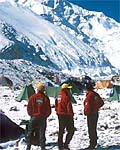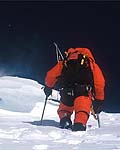|
|
| ||||||||||||||||||||||||||||||||||||
|
First North Americans Ski Shishapangma
Marolt Brothers Make History [CLICK FOR THE INTERVIEW] [CLICK FOR THE VIDEO] 16 JUL 2000 Mike Marolt says it wasn't skiing from the summit of 8031-meter Shishapangma that was difficult, it was hauling the 25-30 pounds of ski gear up the mountain. "There's a reason why it hasn't been done (by a North American) until the year 2000.
"It's just unbelievably difficult to climb at those altitudes, let alone
haul ski gear," said Marolt, who in May, with his twin brother Steve, became the first North Americans to descend the mountain on skis. "It's diffifult to carry anything other than
yourself and some water and some food to the top of an 8000-meter peak."
The Marolts, Aspen, Colorado, locals were
part of an eight-person expedition to Shishapangma (26,290ft), the world's 14th highest
peak.
Shishapangma, which means "the range above the grassy plain," is the only 8000-meter peak located entirely in China. It was first climbed in 1964 by a Chinese team and wasn't opened to foreign climbers until 1978.
The team chose Shishapangma because of its ski-ability. Originally planning to attempt the southwest face, after
studying the route, they found it to be avalanche prone and thus deemed the risk too great. After some research, and a tip from climbing legend Ed Viesturs, they found the standard route on the northern side to be a better ski mountaineering route, as opposed to being purely a climbing route.
Shishapangma is believed to have first been skied by the Polish climbing legend Jerzy Kukuczka, who was also the second person, behind Reinhold Messner, to climb all 14 8000-meter peaks. No North American had ever accomplished a ski descent.
"Ed Viesturs trekked into Broad Peak with us on our permit (in '97), and we
used him as a reference. He said, 'You know, if you guys do the standard
route, with your ability to ski, it's skiable.' And so we chose it based on
that," Mike explained.
The team departed for Nepal on April 20. They were actually able to drive from Kathmandu across the Tibetan border to Base Camp at 16,000 feet. They hiked 25 kilometers (15 miles) to Advanced Base Camp. Without the aid of porters, they carried their own gear up the mountain and established three camps: Camp Zero (19,000 feet), Camp I (21,000 feet) and Camp II (22,000 feet). According to the Marolts, most climbers establish a fourth camp higher up, but they decided against that, thus committing to a 4,000-vertical-foot climb on summit day.
"We got up the morning of the 21st at midnight and we were on the trail by 1am or thereabouts," Mike recalls. "It was a full moon, beautiful night, and it was a 4,000-foot summit day, and probably about 25,000 feet, the clouds blew in."
What had before been clear, perfect conditions soon turned into a raging blizzard. Mike says they weren't scared, but they were concerned.
"The route is such that you're climbing mixed rock and ice the last 2,000 feet. There's fixed line all over the place, and it is a ridge. There's one section coming into what other people use as Camp III, where you could get pretty messed up, but, fortunately, there was a sucker hole and we got through it, moving down and onto a headwall."
Brothers Pushing Boundaries
As twins, Steve and Mike have done things together all their lives. In their ski and mountaineering careers, this includes summitting mountains such as Washington's Rainier, Alaska's Denali, and 10 expeditions to the Wrangell and St. Elias ranges, also in Alaska. This time, as they worked toward their highest goal yet, climbing and skiing an 8000-meter peak, Steve was determined to get skis to the summit, but Mike confessed that skiing from the summit became less of the ultimate goal for him once they got there.
Mike admits, "My original goal was to ski the peak, and then when I got to the peak, I thought, if I can ski from 24,000 or 25,000 feet, I'll be happy, and if I get the peak, that's just gravy."
But Steve remained steadfast on skiing from the summit. He had told Morrow at Advanced Base Camp that if he was going to stand on top of the peak, he would do it on skis. "I believed I could do it then, and I knew we were going to do it," Steve said.
At the beginning of the summit ridge, there were blizzard conditions. Ahead of the group, the Marolts got up to 25,000 feet, and Steve looked at Mike. Mike recalls the moment when, as he refers to it, he couldn't be outdone by his brother.
"We got up to 25, and Steve and I were ahead of the group. He looked at me and he said, 'So, are you going to dump the skis? We're at 25,000.' And I said, 'Well, yeah, maybe,' and he said, 'Great,' kind of sarcastically and just took off. So, I shouldered the skis and away I went."
Further up the ridge, Mike looked up at his brother, who was suddenly sitting down, and said, "Is that the summit?"
Steve put his hands up and that's when Mike knew that was the top, and he was only 20 yards away. "More than realizing that we had carried the skis up there, it was just the fact that we were going to top out on the central peak of Shishapangma," Mike said. "It didn't really dawn on me what we had done, that we had become the first North Americans to ski this thing until I got back down to ABC, and I was just laying in my tent listening to tunes, and I thought, Jesus, this is cool, and I was just really proud. I just kind of got shivers when I started to think about it."
Steve and Mike, with their skis in tow, were the first to the summit around 10:30am. Gile and Silvera also summitted (Morrow, Zhumayev, Serdyuk and Khaibulin, suffering from a non altitude related lung virus, did not summit). There, they made the decision to descend as a group, even though three of the five did not have skis. With his boards strapped on, Steve descended first and waited for the others to downclimb. Mike, also on skis, took the sweep position.
"I was the tailgunner, and I would follow everybody, and we just wanted to make sure that, in case there was an avalanche or something, we were looking out for each other, because it was very avalanche prone and we just didn't want to lose anybody in the whiteout."
They skied from the summit to about 22,000 feet, their high camp, and spent the night there. The next day they skied down to the bottom of the mountain, pulling camps along the way.
Their ski descent comes less than a year after an avalanche on Shishapangma killed outdoor cameraman Dave Bridges, also from Aspen, and climbing legend Alex Lowe, one of the world's greatest alpinists.
Making the Climb Possible
This trip wasn't all about personal goals for the Marolts though, and they found rewards even before reaching Base Camp when they made it possible for three climbers from Kazakstan to join the expedition.
The three Kazakhs, members of the same climbing club as the late Anatoli Boukreev, had had extensive experience on 6000- and 7000-meter peaks, mostly in the Pamir and Tien Shan mountains, but had never before attempted an 8000-meter peak. Along with 47-year-old Vadim Khaibulin, a mentor to Boukreev, was 28-year-old Andrey Serdyuk, who has an amazing nine 7,000-meter summits under his belt and 23-year-old Maxut Zhumayev.
The expedition also included high school friend and longtime climbing partner of the Marolts, Jim
Gile, also of Aspen.
Without state-sponsored funds that had been available under the old communist
government, it was nearly impossible for the Kazakh climbers to pay for an expensive, Himalaya-scale expedition. So,
together, the three Aspenites raised the needed funds to bring the three Kazakhs, whom they met during an expedition to Pik Lenin last year.
"We believed that after climbing with them bearing loads on Pik Lenin that these guys would really help us get to the top of Shishapangma," Steve explained. "They're
incredibly strong, gifted individuals, and so we just hit the pavement and
raised the money to take these guys."
After a failed attempt on Broad Peak in '97, the Marolts realized they might increase their chances of success on an 8000-meter summit by expanding the size of their group. Avalanche conditions that year had forced their small team to turn back at 25,500 feet. "We went with a four-man team, and we thought, you know, we need a little more economy of scale," Steve said.
"We knew
these guys (the Kazakhs). They obviously had a lot of experience, and we
just said, well why don't we just try to throw it together and turn a
relatively small team into a decent sized team. So that's the reason why we did it," he said.
The expedition was rounded out by Cheri Silvera and Pat Morrow, both of whom served as high-altitude camera people for the expedition. Morrow in 1986, by way of Indonesia's Carstensz Pyramid, became the first person to successfully climb the Seven Summits.
Five Generations of Skiers
Mike and Steve Marolt come from a long line of skiers. They are
fifth-generation Aspen locals with two Olympians (one of whom was also a
coach) and a FIS racer in their family. The twins grew up skiing with their
father, Max. In their family, skiing is a way of life.
"You know, I just never matured into the level ski racers that they were, but it gave me the skill," Mike explained.
From the time they were in high school, Steve and Mike were always up in the high mountains, touring around
the Elks, and they always had skis. Their father introduced them to backcountry skiing by getting them up early in the mornings as youngsters and taking them out into the mountains.
"Even before we could drive, when we were like 12 years old, I can remember my dad, in the summer, would get us up at like 4:30 or 5 o'clock in the morning and we would jump in the car and we would drive up to Independence
Pass just outside of Aspen, and it's above timberline skiing, and you've got to hike and climb to get to the skis. He would go with us and we would ski down and then hitchhike back up to the top and just do loops like that."
After climbing and skiing his first 8000-meter peak, Mike admits that the reason most people don't haul skis up is because it's so difficult, and it's such an expensive proposition just to climb it, let alone ski it.
"When you consider the time away from work and just the actual costs, people don't want to take a chance of not getting the summit because they've got ski gear holding them down, holding them back."
But Mike and Steve Marolt didn't let their ski gear hold them back. What is next? The highest mountain on earth. Though it has been attempted, Everest has never been skied by a North American...yet.
— Michelle Quigley, MountainZone.com Staff
MORE FRESH TRACKS: Go there
|
|
||||||||||||||||||||||||||||||||||


